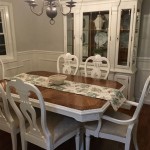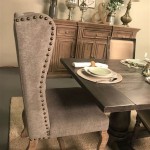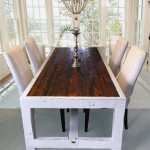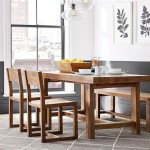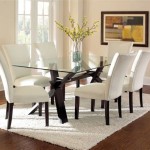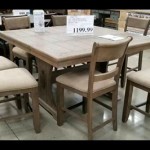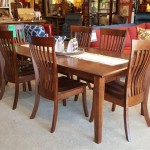Screws For Dining Table Legs: A Comprehensive Guide
The seemingly simple act of attaching dining table legs relies heavily on the quality and appropriate selection of screws. These unassuming fasteners are the critical link between the table legs and the tabletop, bearing the weight of the table and everything placed upon it. A failure in this connection can lead to instability, damage, and potential injury. Therefore, understanding the types of screws, factors influencing their selection, and proper installation techniques is essential for ensuring a structurally sound and durable dining table.
Choosing the correct screws for this application requires careful consideration of several factors, including the material of the table legs and tabletop, the weight the table is expected to bear, the intended lifespan of the table, and the overall aesthetic considerations. Neglecting these factors can lead to a compromised table that may require frequent repairs or even complete replacement.
Understanding Screw Types and Their Applications
The market offers a wide variety of screws, each engineered for specific purposes. Understanding the different types and their characteristics is crucial for selecting the most appropriate screws for attaching dining table legs. The most common types used in furniture construction include wood screws, lag screws, and connector bolts, each distinguished by their design and application.
Wood screws, as the name implies, are specifically designed for wood applications. They feature a tapered shank and threads designed to grip the wood fibers, providing a strong and secure hold. The head of a wood screw can vary in shape, including flat, round, and oval, to accommodate different aesthetic and functional requirements. Flat head screws are typically used when a flush finish is desired, while round head screws provide a more decorative appearance. Oval head screws offer a compromise between the two.
Lag screws, also known as lag bolts, are significantly larger and stronger than standard wood screws. They feature a coarse thread and a hexagonal head, requiring a wrench or socket for installation. Lag screws are ideal for applications requiring high holding power, such as attaching thick table legs to a substantial tabletop. Due to their size and strength, lag screws can withstand significant weight and stress.
Connector bolts, also known as furniture bolts or confirmat screws, offer a clean and concealed method of attaching table legs. They consist of a bolt and a barrel nut that is inserted into a pre-drilled hole in the tabletop. When the bolt is tightened, the barrel nut expands, creating a tight and secure connection. Connector bolts are particularly well-suited for tables with aprons or skirts, providing a neat and professional finish. They are often favored for their aesthetic appeal and ease of assembly.
Factors Influencing Screw Selection
Selecting the appropriate screws for dining table legs involves a careful assessment of several key factors. The material of the table legs and tabletop, the weight-bearing capacity required, the desired aesthetic, and the longevity of the table all play a significant role in the decision-making process. Choosing the wrong screws can lead to structural instability, premature failure, and aesthetic inconsistencies.
The material of the table legs and tabletop is a primary consideration. Different wood types have varying densities and hardness, affecting the screw's ability to grip and hold. Softwoods, such as pine and fir, require screws with a coarser thread to ensure a secure hold. Hardwoods, such as oak and maple, can accommodate screws with a finer thread. When attaching metal legs to a wooden tabletop, specialized screws designed for joining dissimilar materials or the use of threaded inserts within the wood may be necessary. If the tabletop is made of a composite material, such as MDF or particleboard, screws with a specialized thread pattern and a pilot hole may be required to prevent splitting or crumbling.
The weight-bearing capacity of the dining table is another critical factor. Tables intended to support heavy loads, such as those used for large family gatherings or displaying heavy objects, require stronger and more numerous screws. Lag screws are often the preferred choice for these applications, as they offer superior holding power. The number of screws used per leg should also be carefully considered, with more screws providing greater stability and support. A table intended for light use, such as a small breakfast table, may only require standard wood screws.
Aesthetic considerations also play a role in screw selection. The type of screw head, its finish, and its visibility can all impact the overall appearance of the dining table. Countersunk screws, which sit flush with the surface of the wood, are often preferred for a clean and unobtrusive look. Screws with decorative heads can be used to add a touch of visual interest. The finish of the screws should also complement the overall design of the table, with options such as brass, chrome, and black available to match different styles.
Finally, the desired longevity of the dining table should be considered. If the table is intended to last for many years, it is essential to choose high-quality screws that are resistant to corrosion and wear. Stainless steel screws are an excellent choice for long-term durability, as they are highly resistant to rust and degradation. Using cheaper, low-quality screws may save money in the short term, but it can lead to premature failure and the need for costly repairs in the future.
Proper Installation Techniques for Optimal Screw Performance
Even the best screws will not perform optimally if they are not installed correctly. Proper installation techniques are essential for ensuring a secure and durable connection between the dining table legs and the tabletop. This includes drilling pilot holes, using the appropriate tools, and avoiding over-tightening the screws.
Drilling pilot holes is a crucial step in preventing wood from splitting and ensuring that the screws can be driven in straight and true. The size of the pilot hole should be slightly smaller than the diameter of the screw's shank. This allows the threads of the screw to grip the wood fibers without causing them to crack. Pilot holes are particularly important when working with hardwoods or when driving screws close to the edge of the wood. For softwoods, pilot holes may not always be necessary, but they can still help to ensure a clean and accurate installation.
Using the appropriate tools is also essential for successful screw installation. A screwdriver that is the correct size and type for the screw head is crucial for preventing slippage and damage to the screw head. Power drills can be used to drive screws quickly and efficiently, but it is important to use a low speed and to avoid over-tightening. When using lag screws, a socket wrench or adjustable wrench is required to provide sufficient torque for driving the screw into the wood.
Over-tightening screws is a common mistake that can lead to stripped threads, damaged wood, and a weakened connection. When driving screws into wood, it is important to stop tightening as soon as the screw head is flush with the surface. Over-tightening can compress the wood fibers, reducing the screw's holding power. If the screw head starts to strip, it is best to stop tightening and try a different screw or a different location. Using a torque limiter on a power drill can help to prevent over-tightening.
For connector bolts, proper alignment of the bolt and barrel nut is essential for a secure and stable connection. The barrel nut should be fully inserted into the pre-drilled hole before tightening the bolt. If the bolt and barrel nut are not properly aligned, the connection may be weak or unstable. It is also important to use the correct size of bolt and barrel nut for the thickness of the tabletop.
In addition to these basic techniques, there are several other tips that can help to ensure successful screw installation. Applying a small amount of lubricant, such as beeswax or soap, to the screw threads can make it easier to drive the screws into the wood. Using a countersinking bit can create a neat and professional-looking recess for the screw head. And finally, always inspect the screws for any signs of damage or defects before installation. Damaged screws can be weaker and more likely to fail, compromising the structural integrity of the dining table.
By carefully considering the factors influencing screw selection and following proper installation techniques, it is possible to create a dining table that is not only beautiful but also strong, durable, and safe for years to come. The seemingly small detail of screw selection and installation is a critical component in the overall quality and longevity of the finished piece.

The Project Lady How To Build A Farmhouse Table Post 2 Adding Hanger Bolts Legs

The Project Lady How To Build A Farmhouse Table Post 2 Adding Hanger Bolts Legs

Joinery Hanger Bolts On Chair Legs Keep Coming Loose Woodworking Stack Exchange

Hardware And Table Legs Jeff Mack Supply

3 Ways To Attach Table Legs Wikihow

8 Easy Ways To Attach Furniture Feet Tablelegs

The Project Lady How To Build A Farmhouse Table Post 2 Adding Hanger Bolts Legs

Vevor 28 In Dining Table Legs

8 Easy Ways To Attach Table Legs Tablelegs

Diy Dining Table Build It For 75 Pine And Poplar

